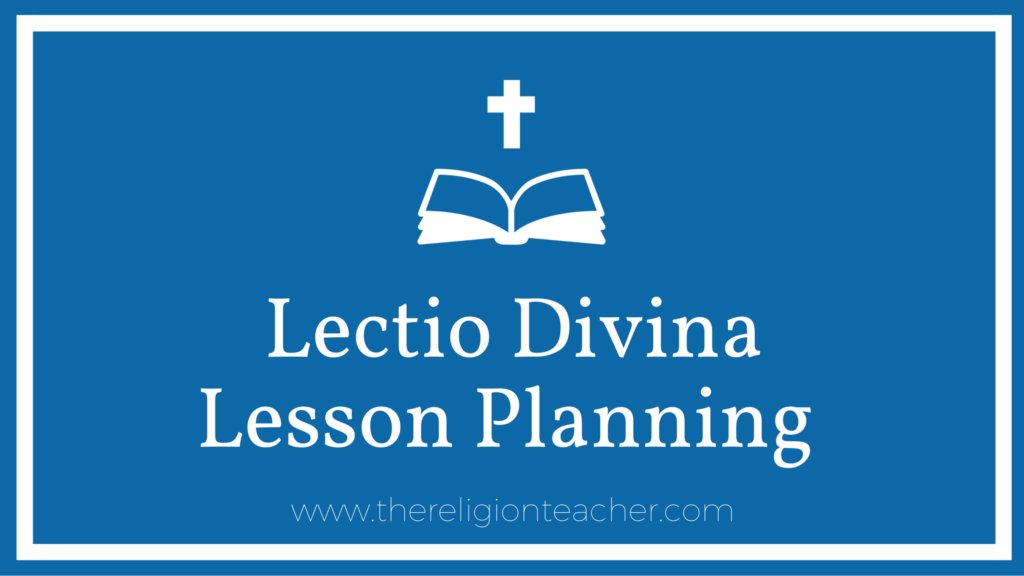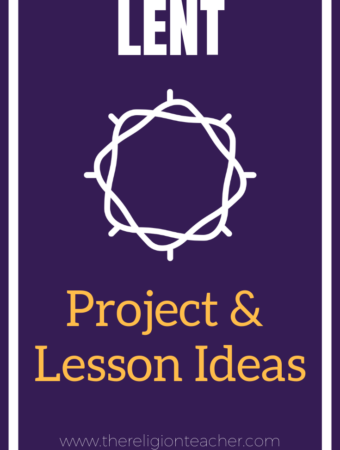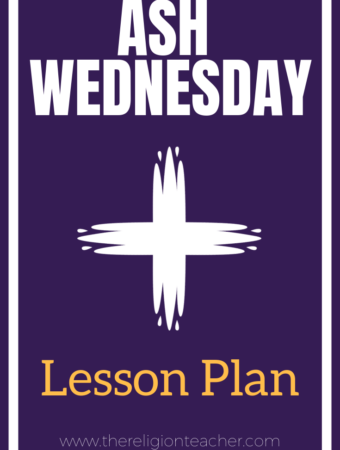
This concept was so effective for religious educators who started using it in class, that I expanded it into an entire book on lesson planning: Christ in the Classroom: Lesson Planning for the Heart and Mind.
How do we help our students know, love, and serve God?
How do we teach both the head AND the heart?
As religious educators, we must achieve a balance between the head and the heart. Teaching just the head won’t do. We want our students to enter into a relationship with Jesus Christ and learn accept his love while attempting to love him back.
As St. John Paul II wrote about catechesis:
“The definitive aim of catechesis is to put people not only in touch but in communion, in intimacy, with Jesus Christ . . .” (Catechesi Tradendae, 5)
So, how do we do that? How do we achieve that essential balance between instructing the mind and inspiring the heart?
Our answer is actually quite ancient.
It comes from our rich Catholic heritage.
It is an approach to reading the Bible that highlights a personal encounter and leads to conversion.
This approach is popularly known lectio divina.
Lectio divina is Latin for “sacred reading.” It is a term that has been used to refer to a wide variety of methods all with one objective: an encounter with Christ in his word.
I have written in the past about the basic steps of Lectio Divina in the past. You can find that article here or watch this video:
Lectio Divina Lesson Planning
I have a really important suggestion here that could truly transform your approach to religious education.
What if we took that same process for encountering God in Sacred Scripture and applied it to everything we teach?
What if we took every topic we introduced to our students through a process of lectio, meditatio, oratio, contemplatio, and actio?
The results can be pretty incredible.
Applying lectio divina to every class will flip your approach from teaching just the head into a process of teaching both the head and touching the heart.
Essentially, it means leading your students to answer these questions:
- Learn: What does this teaching mean?
- Meditate: What is Christ saying to me?
- Pray: What can I say to Christ in response?
- Contemplate: What conversion of the mind, heart, and life is Christ asking of me?
- Act: How will I make my life a gift for others?
Here is the original video I created to explain the concept of Lectio Divina Lesson Planning might look like in this video (and I’ll go into greater detail below):
Learn (Lectio)
Learn: What does this teaching mean?
It is no coincidence that the root word in Latin for “lecture” is lectio. A lecture is a one-way form of teaching. We explain something that everyone can hear and comprehend. The Latin word lectio means reading. So if we’re not lecturing in class to introduce new ideas, we are likely having students read or spending time reading to them ourselves.
(Important Note: Limit your lecture and reading time in case as much as possible. The vast majority of your class time should be spend doing what follows. We want students that are ACTIVEly engaged. More on that in this article.)
Lectio falls into what I refer to as the “Present” phase of a the simple lesson planning structure. The bulk of class should be spent on the “Practice” phase. Then at the end, you “Check” to see where students are and decide if you need to re-present and plan additional activities to put what they have learned into practice.
Here’s another video. This one will get you up to speed on this three-step process if you are not familiar with it:
Now we want our students to apply what they have learned through various activities.
We want to make sure they understand the main ideas of what we explained to them. We want to make sure they are able to meet the learning objective we set for them at the top of our lesson.
At The Religion Teacher you will find a wide variety of activities to use in this part of your lesson. Also, premium members have access to a large library of videos and graphic organizers to help students learn new ideas.
Meditation (Meditatio)
Meditate: What is Christ saying to me?
Now here is where we shift from the head to the heart.
According to Pope Benedict XVI, meditation during Lectio Divina seeks to answer: “What does this say to me, today, and to my life?”
To do this, we need to invite our students to reflect on what they have learned. We need to help them see how what we have taught them is relevant and personal to their lives. We need to help them encounter Christ in some way or at least recognize that christ has something he wants to say to us through this lesson.
There are a lot of activities to help young people make these connections. Guided journal meditations can be great for this part of your lesson.
The Religion Teacher’s Weekly Reading Worksheets are examples of ways to do this as well.
The key is to find or ask questions that really do make what we have taught as personal as possible to the students.
Prayer (Oratio)
Pray: What can I say to Christ in response?
For some reason it is easy for religious educators to take on a limited view of class prayer. I know I did. I used to think of prayer as only something we did as an important way to start or end the class and nothing more.
The way I was integrating prayer early on, it was as though I was thinking: “Let’s get prayer out of the way and then we can get to work.”
This is a significant missed opportunity.
Many of us tend to throw prayer in at the beginning of class or at the end right before students leave. Praying before and after class is important and a habit to stick to without a doubt, but that is not where we should stop.
As Catholics we have an ancient phrase about prayer and belief: lex orandi, lex credendi. It means “the law of prayer is the law of belief.” What we pray is what we believe.
Therefore, when students pray they put into practice what they have learned. Prayer is an essential way to learn!
So, plan prayer experiences that continue to integrate what you have taught with the students’ personal lives. Give them the opportunity to pray in a way that expresses what they have learned.
When we pray, we say something to God. It is a response to what he has said to us in our meditation.
Find Catholic devotions or prayer practices that fit best or design your out liturgical experience to give students the opportunity to respond to converse with God about what they have learned.
At the very least, by praying in this way you connect what they have learned to something they will pray repeatedly. That will give those prayers deeper meaning for them in the future.
Contemplation (Contemplatio)
Contemplate: What conversion of the mind, heart, and life is Christ asking of me?
The next phase of lesson planning is the “check” and in a Lectio Divina Lesson Plan that can be an opportunity for contemplation.
What do we mean when we talk about contemplation?
This video will help explain:
According to Pope Benedict XVI’s line of Lectio questioning, we ask: “What conversion of the mind, heart, and life is the Lord asking of me?”
In a lot of ways, the contemplation step is like the penance you receive in the Sacrament of Reconciliation. That penance is an act by which you live out in deed what is already transformed in your mind and heart.
Think of it like a homework assignment. What can the students do in their personal lives to show they have been transformed through an encounter with Christ?
Challenge them to contemplate the change and commit to taking action.
Action (Actio)
Act: How will I make my life a gift for others?
The natural last step of any lesson is to consider how students can live what they learned. How will your students apply what they have learned in their daily lives?
Action takes place after the lesson and is often not easy for us to see. The seeds that are planted in a lesson may not bear fruit right away, but we can place our trust in the Holy Spirit to continue to work through their classroom encounters to lead our students closer to Christ.
Think of this final step as an ungraded, even optional homework assignment. Whether the students are given the opportunity to carry out these actions is left in the hands of the Lord. And whether they rise up to the challenge when given the opportunity will depend on the level at which they experienced a true transformation in their encounter with Christ.
Lectio Divina Lesson Plan Examples
Here are a few examples of lesson plans that use the Lectio Divina approach. Notice how each of them is not necessarily focused on Scripture, yet the process is the same. We can apply this process to anything we teach.
Note: In these early examples, I did not provide ideas for the last step in Lectio Divina Lesson Planning (action).
Lectio Divina Lesson Plan: The Common Good
You can watch or share this video with students about the Common Good.
Lectio Divina Lesson Plan: Apostolic Succession
Get Hundreds of Lectio Divina Resources
I feel so strongly about this approach to religious education that I have spent the last three years creating resources to directly help teach students to learn, meditate, pray, and contemplate conversion.
In The Religion Teacher membership website there are more than 350 worksheets that guide students through a process of one or more phases of Lectio Divina. There is one worksheet for every Sunday Gospel as well as dozens others for various topics: Genesis, Ten Commandments, Lectio Divina, Confirmation, the Catholic Mass, Catholic Social Teaching, Advent, Lent, and more.
Members also have access to dozens of class videos and graphic organizers and online courses for professional development and spiritual formation.



Great presentation
What if we applied Lecio to everything we taught? YES! Well done.
“Teaching just the head won’t do. We want our students to enter into a relationship with Jesus Christ and learn accept his love while attempting to love him back.”
– Well said.